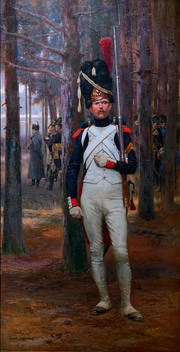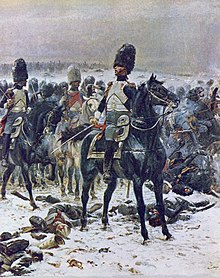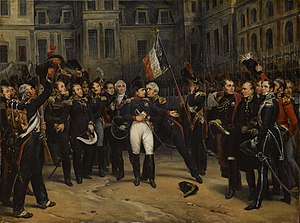Old Guard (France)
This article needs additional citations for verification. (August 2017) |
| "La Vieille Garde" (The Old Guard) | |
|---|---|
 | |
| Active | 1804–1815 |
| Country | France |
| Branch | French Army |
| Engagements | Napoleonic Wars |
| Commanders | |
| Notable commanders | Dorsenne Bessières Davout Soult Cambronne |
The Old Guard (French: Vieille Garde) were the veteran elements of the Emperor Napoleon's Imperial Guard. As such it was the most prestigious formation in Napoleon's Grande Armée. French soldiers often referred to Napoleon's Old Guard as "the Immortals".[1]
It is believed[citation needed] that Napoleon hand-selected members of his Old Guard based on physical traits, most notably above-average height. Their imposing stature was likely impressive to foes and allies alike. Awards as well as veterancy were also taken into consideration when selecting troops for the Old Guard.
Old Guard infantry[]

There were four regiments of Old Guard infantry: 1st and 2nd each of grenadiers and chasseurs. Members of the Old Guard benefitted from a number of different privileges, including considerably increased wages from the Imperial Guard.
Requirements for Old Guard candidates[]
- under 35 years of age at entry
- at least 10 years of service
- at least three campaigns (some had fought in as many as 12 campaigns)
- had to have faced enemy fire at the front
- had to be 5 feet 8 inches (1.73 m) for the Chasseurs and 5 feet 10 inches (1.78 m) for the Grenadiers (no height requirement for those awarded the Legion of Honor)[2]
In 1814 the 1st Chasseurs still had many old-timers: for example Sapper Rothier with 21 years of service and two wounds; Private Stoll with 22 years of service and 20 campaigns. Those who were too old, or crippled, were sent to the Company of Veterans in Paris, which was full of soldiers, some lacking an arm, others striped with saber cuts.
Each member of the Old Guard was a highly trained and experienced soldier and they formed a formidable sight on the battlefield when mustered into regiments; they were taught to fight unlike any other soldier in the French army. Any cowardly tendencies or otherwise cautious habits would be thoroughly purged through intense training, which often included advanced bayonet and hand-to-hand combat techniques. The Old Guard earned its fearsome reputation through the many military engagements of the Napoleonic Wars, from the Battle of Austerlitz, to the Battle of Dresden, to the famous and final Battle of Waterloo (June 1815).
Old Guard cavalry[]

There were four regiments of Old Guard cavalry: the Grenadiers à Cheval (mounted grenadiers), Chasseurs à Cheval (mounted chasseurs), Dragons de l'Impératrice (the Empress's Dragoons), and the 1st Polish Lancers.
The Mamelukes of the Imperial Guard squadron was also considered part of the Old Guard cavalry.
The Gendarmes d'élite (elite Gendarmes) was counted as Old Guard cavalry. It was deployed in detachments as escorts for Napoleon's headquarters and the General Staff of the Guard, and for Imperial Guard field camps.[citation needed]
Les Grognards[]
Another privilege reserved only for the members of the Old Guard was the freedom to express their discontent freely: the Old Guard Grenadiers were known as "the Grumblers" (French: les Grognards) because they openly complained about the petty troubles of military life.[3] Jean-Roch Coignet, a captain of the Imperial Guard, claimed that this term was coined in the aftermath of severe hardships the unit encountered during the War of the Fourth Coalition.[4] Some of the officers even did so in the presence of the Emperor, knowing that the Old Guard's reputation commanded enough respect with Napoleon to allow such openness. Such behavior was unique to the Old Guard and would have been severely punished were it engaged in by a member of any other unit.
End of the Old Guard[]

The Old Guard was disbanded by the victorious Sixth Coalition in 1814, along with the rest of the Imperial Guard.
During Napoleon's 1815 return from exile, the Old Guard was reformed, and fought at the Battle of Waterloo, where the 2e Regiment de Grenadiers-à-Pied was pivotal in the defense of the village of Plancenoit against the Prussians.[5] The 1er Regiment, charged with protecting the field position around Napoleon himself, served as a rear guard after the failure of the attack of the Middle Guard on the British center.[6] The Old Guard cavalry was involved in the unsuccessful midday charges against the British infantry, and was unavailable at the battle's decisive moments.
In August 1815, Louis XVIII ordered the Imperial Guard abolished. By December, all the Old Guard regiments were disbanded. Ex-guardsmen ended up in a variety of places after their units' disbandment. Some re-enlisted into the king's army. Most lived out their lives watched with suspicion by Bourbon police. When Napoleon's body was returned to France in 1840, many of the surviving Old Guard paraded in threadbare uniforms.
Contemporary use[]
Nowadays, in France, the expression la vieille garde (without uppercase) is used when talking about longtime close followers of a politician and has a mildly pejorative meaning. This expression is particularly popular among political journalists.[citation needed] "The old guard" can pejoratively refer to any outdated establishment in English as well. Grognard is also a slang term used by the tabletop role playing and wargaming community to refer to older, long term players of such games. The usage started with Napoleonic miniature war gaming, and originally referred to those who would seek out minor details that were wrong with another’s painting or modeling, mostly in terms of historical accuracy. Various online forums have popularized the usage among the tabletop role playing and war gaming community.[citation needed]
See also[]
References[]
- ^ Georges Blond, La Grande Armée, trans. Marshall May (New York: Arms and Armor, 1997), 48, 103, 470
- ^ me. "Napoleon's Guard Infantry (Young Guard, Old Guard)". napolun.com. Retrieved 2 February 2018.
- ^ Mould, Michael (2011). The Routledge Dictionary of Cultural References in Modern French. New York: Taylor & Francis. p. 153. ISBN 978-1-136-82573-6. Retrieved 3 June 2012.
- ^ Coignet, Jean-Roch, and J. W. Fortescue. The note-books of Captain Coignet: soldier of the empire, 1799-1816 (London: Greenhill Books, 1998), 131.
- ^ Old Guard Grenadiers in Plancenoit (retrieved 2010-08-10)
- ^ The Last Squares of the Old Guard (retrieved 2010-08-10)
External links[]
- French military units and formations of the Napoleonic Wars
- Military units and formations disestablished in 1815
- Military units and formations established in 1804
- Regiments of Napoleon I's Imperial Guard